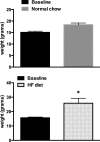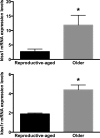Ovarian kisspeptin expression is related to age and to monocyte chemoattractant protein-1
- PMID: 26879207
- PMCID: PMC4818642
- DOI: 10.1007/s10815-016-0672-x
Ovarian kisspeptin expression is related to age and to monocyte chemoattractant protein-1
Abstract
Purpose: The objective of this study was to test the hypothesis that ovarian kisspeptin (kiss1) and its receptor (kiss1r) expression are affected by age, obesity, and the age- and obesity-related chemokine monocyte chemoattractant protein-1 (MCP-1).
Methods: Ovaries from reproductive-aged and older C57BL/6J mice fed normal chow (NC) or high-fat (HF) diet, ovaries from age-matched young MCP-1 knockout and young control mice on NC, and finally, cumulus and mural granulosa cells (GCs) from women who underwent in vitro fertilization (IVF) were collected. Kiss1, kiss1r, anti-Mullerian hormone (AMH), and AMH receptor (AMHR-II) messenger RNA (mRNA) expression levels were quantified using real-time polymerase chain reaction (RT-PCR).
Results: In mouse ovaries, kiss1 and kiss1r mRNA levels were significantly higher in old compared to reproductive-aged mice, and diet-induced obesity did not alter kiss1 or kiss1r mRNA levels. Compared to young control mice, young MCP-1 knockout mice had significantly lower ovarian kiss1 mRNA but significantly higher AMH and AMHR-II mRNA levels. In human cumulus GCs, kiss1r mRNA levels were positively correlated with age but not with BMI. There was no expression of kiss1 mRNA in either cumulus or mural GCs.
Conclusion: These data suggest a possible age-related physiologic role for the kisspeptinergic system in ovarian physiology. Additionally, the inflammatory MCP-1 may be associated with kiss1 and AMH genes, which are important in ovulation and folliculogenesis, respectively.
Keywords: Aging; Kisspeptin; MCP-1; Obesity; Ovary.
Figures





Similar articles
-
Leptin suppresses anti-Mullerian hormone gene expression through the JAK2/STAT3 pathway in luteinized granulosa cells of women undergoing IVF.Hum Reprod. 2013 Jun;28(6):1661-9. doi: 10.1093/humrep/det072. Epub 2013 Mar 15. Hum Reprod. 2013. PMID: 23503941
-
Loss of LH-induced down-regulation of anti-Müllerian hormone receptor expression may contribute to anovulation in women with polycystic ovary syndrome.Hum Reprod. 2013 Mar;28(3):762-9. doi: 10.1093/humrep/des460. Epub 2013 Jan 14. Hum Reprod. 2013. PMID: 23321213
-
Increased Expression of KISS1 and KISS1 Receptor in Human Granulosa Lutein Cells-Potential Pathogenesis of Polycystic Ovary Syndrome.Reprod Sci. 2019 Nov;26(11):1429-1438. doi: 10.1177/1933719118818899. Epub 2018 Dec 30. Reprod Sci. 2019. PMID: 30595091
-
Anti-Müllerian hormone (AMH): regulator and marker of ovarian function.Ann Endocrinol (Paris). 2010 May;71(3):191-7. doi: 10.1016/j.ando.2010.02.016. Epub 2010 Apr 2. Ann Endocrinol (Paris). 2010. PMID: 20362961 Review.
-
[What's new in 2014 about anti-Müllerian hormone?].J Gynecol Obstet Biol Reprod (Paris). 2014 Oct;43(8):559-71. doi: 10.1016/j.jgyn.2014.06.004. Epub 2014 Jul 17. J Gynecol Obstet Biol Reprod (Paris). 2014. PMID: 25042625 Review. French.
Cited by
-
Kisspeptin and GPR54 Receptor Expression in Endometrial Cancer Tissue.Cancers (Basel). 2023 Feb 15;15(4):1228. doi: 10.3390/cancers15041228. Cancers (Basel). 2023. PMID: 36831570 Free PMC article.
-
Potent Vasoconstrictor Kisspeptin-10 Induces Atherosclerotic Plaque Progression and Instability: Reversal by its Receptor GPR54 Antagonist.J Am Heart Assoc. 2017 Apr 14;6(4):e005790. doi: 10.1161/JAHA.117.005790. J Am Heart Assoc. 2017. PMID: 28411243 Free PMC article.
-
Role of adiponectin in ovarian follicular development and ovarian reserve.Biomed Rep. 2019 Jun;1(1):1-5. doi: 10.3892/br.2019.1213. Epub 2019 May 17. Biomed Rep. 2019. PMID: 31258901 Free PMC article.
-
Maternal cafeteria diet adversely affects the reproductive parameters of rat offspring in a sex-specific manner.Reprod Biol Endocrinol. 2025 May 26;23(1):79. doi: 10.1186/s12958-025-01412-0. Reprod Biol Endocrinol. 2025. PMID: 40420282 Free PMC article.
-
The kisspeptin system in and beyond reproduction: exploring intricate pathways and potential links between endometriosis and polycystic ovary syndrome.Rev Endocr Metab Disord. 2024 Apr;25(2):239-257. doi: 10.1007/s11154-023-09826-0. Epub 2023 Jul 28. Rev Endocr Metab Disord. 2024. PMID: 37505370 Review.
References
Publication types
MeSH terms
Substances
Grants and funding
LinkOut - more resources
Full Text Sources
Other Literature Sources
Medical
Research Materials
Miscellaneous

